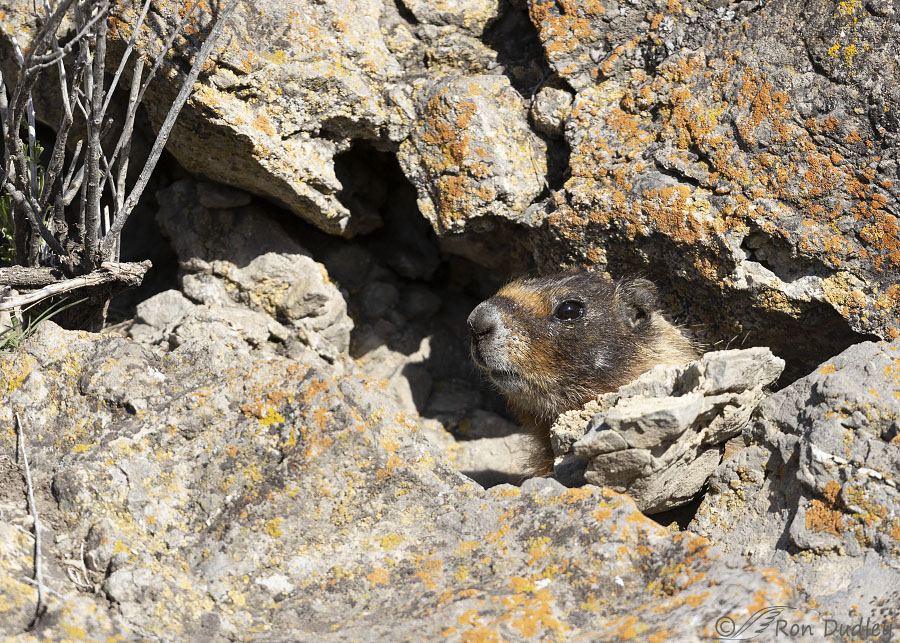Cryptic coloration isn’t just for the birds.

1/3200, f/6.3, ISO 640, Canon R5, Canon EF500mm f/4L IS II USM + 1.4 tc, not baited, set up or called in
Five days ago in a remote area of northern Utah I was amazed by how well this young marmot pup was hidden, even though it was very well lit in the early morning sun. The pup was pointed out to me so I knew precisely where to look and what I was looking for and it wasn’t very far away but I’ll be damned if I could spot it.
I stared at that small area of the rocky outcrop for almost a minute before the pup moved its head a little and I finally spotted it. Now it’s true that I don’t have the best eyesight in the world but it isn’t all that bad either.
Once again I was impressed by just how well cryptic coloration actually works. In northern Utah most of our exposed rocks are covered with these orange lichens and the rock piles are ideal habitat for marmots. Marmots are on the menu for every medium-sized to large predator in the area so that’s a recipe for selection pressure and evolution. Just look how closely the color of the lichens on the rocks matches some of the colors of the marmot and the marmot’s darker colors and patterns closely mimic the shaded areas in the rocks.
In the natural world cryptic coloration is closer to the rule than it is to the exception so it makes me wonder how some carnivores find enough to eat.
Ron


Movement. Just like any youngster, they just can’t stay still as long as necessary!
Interesting point, Arwen. But this guy was being pretty darn good about it.
Cryptic coloration aside (and ain’t Natural Selection fascinating?!!), that is one adorable pup!
Glad you think so, Marty.
While I readily accept the concept of cryptic coloration, I wonder if there is another evolutionary process at work here. Call it infantile appearance evolution. So many young offspring of all kinds of species are just adorable. Not sure if that is anthropormophism or not.
Lyle, I too have wondered about the origin of cuteness as perceived by humans. There must be something to it, especially because it crosses species and even class lines.
She who pointed it out to you definitely has predator instincts. A ‘Benign predator’ in action. I doubt I would have seen it either.
Nature is amazing and yes, as others have said, this is a super cute example.
EC, I have to wonder how many of its siblings might have been in those rocks that I didn’t see. Maybe none, maybe several.
Great picture illustrating camouflage!! And what a cute critter!
Thank you, Joanne.
Baby season is so fun with cute critters! Predators have special eyesight that often do not see colors as we do and they are very attuned to motion. Jon can’t see animals and birds when I point them out either unless they move, (maybe I will tease him he has predator receptors and needs motion to detect animals) He usually tells me I making up stories about seeing animals. Most of the time I just enjoy the sight and don’t mention it anymore.
April, I’m convinced that if this little guy hadn’t moved a little I’d never have seen him, even though I knew almost exactly where he was.
Thanks for the phrase of the day ‘cryptic coloration’ and the nat geo link. Fascinating! The ‘stick bug’ is invisible! The marmot is darn cute
I think he’s cute too, Kathleen. They always are at that age.
I think that is about the best natural camouflage I have ever seen. The camera and the photo of course make it easier to see, but for those in nature other than maybe an eagle it could be difficult to spot. How far away where you when you spotted it? And of course you are always looking for photo ops, most people just walking around the area would probably never see it.
Everett, I’d guess I was about 25-30′ from it. Truth be told I’d never have seen it if it hadn’t been pointed out to me.
The DO “blend into the woodwork” as the saying goes……. SO many critters are hard to spot until they move even if one knows they are there. Beautiful capture, Ron.
SO many critters are hard to spot until they move even if one knows they are there. Beautiful capture, Ron.
Thanks, Judy.
Wow, cryptic coloration! A new phrase and it says so much. The photo is such a great illustration. Thanks again, Ron!
Then I’m glad I included a link to explain the term. Thanks, Mary.
Isn’t wildlife amazing?!
Yup.